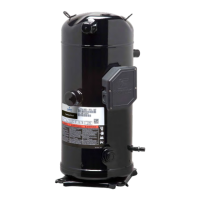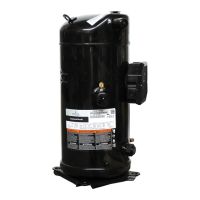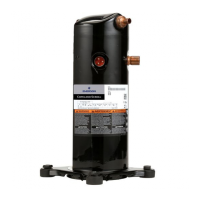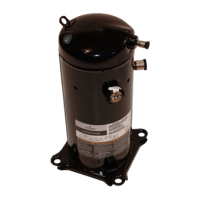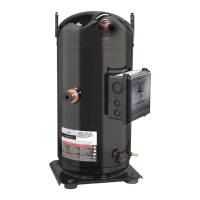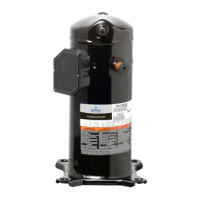34 AGL_HP_VS_YHV2P_E_Rev0
7 Troubleshooting
Most in-warranty electrical failures are the result of mechanical problems (particles in the oil, liquid
refrigerant in the oil, etc.) and most mechanical problems are the result of system problems. Unless
the reason for the failure is found, replacing the compressor will probably lead to another compressor
failure.
If the compressor fails to start and run properly, it is important that the compressor be tested to
determine its condition. It is possible that electrical components may be defective, the protector may
be open, or a safety device may be tripped. The most common compressor problems encountered
in the field are listed below.
WARNING
Electrical connections! Electrical shock hazard! Before attempting any
electrical troubleshooting, make sure all grounds are connected and secure
and there is ground continuity throughout the compressor system. Also ensure
the compressor system is correctly grounded to the power supply. If you are
not a qualified service person familiar with electrical troubleshooting
techniques, DO NOT PROCEED until a qualified service person is available.
When troubleshooting a compressor in combination with the drive please follow the
recommendations below:
▪ Before servicing shut off and secure the power supply. Wait for 2 minutes before performing any
servicing on the drive.
▪ Drive: Check all the external wiring for miss-wiring, broken leads or a cable short circuit. Check
for loose or burned contacts. Check for burned components on the board.
▪ Chokes/PFC: Check all the wiring and check for loose or burned contacts.
▪ External sensors: Make sure that the external sensors are properly connected and still working
(discharge temperature sensor and high-pressure switch).
▪ Drive cooling: For air-cooled drives, make sure that the airflow is not obstructed.
▪ EMI filter: Check all the wiring and check for loose or burned contacts on the board.
▪ Compressor: Make sure the compressor is running within the envelope. Check the winding
resistances from the compressor motor and the cables between compressor and drive. Check for
loose or burned contacts.
The Scroll
compressor does
not run, instead a
buzz sound can be
heard
Check the power supply on the compressor terminals if
there is voltage measured. Trace the wiring diagram to
see where the circuit is interrupted.
If the voltage falls below 90% of the nameplate voltage,
the motor may develop insufficient torque. Make sure
the compressor is supplied with rated nominal voltage.
Defective
capacitor or
relay
For a single-phase motor, a defective capacitor or relay
may prevent the compressor from starting. Check these
components by substituting “a known-to-be-good”
component if available. Make sure that the capacitors
are electrically discharged before checking.
Shorted or
grounded
motor windings
Check the motor for ground by means of a continuity
check between the terminals. If grounded replace
compressor.
Internal
compressor
mechanical
damage
▪ Refrigerant migration: When the compressor is
switched off for a long period refrigerant can
condense in the crankcase. If the compressor body
is colder than the evaporator, refrigerant will move
from the evaporator to the compressor crankcase.
Refrigerant migration normally occurs when the
compressor is installed in a cold area. A crankcase
heater and/or a pump-down cycle provide good
protection against refrigerant migration.
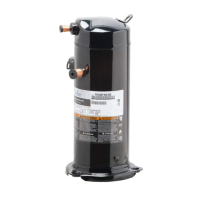
